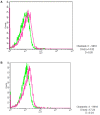Presence of HPV 16 and HPV 18 in Spermatozoa and Embryos of Mice
- PMID: 34697151
- PMCID: PMC8627744
- DOI: 10.21873/invivo.12615
Presence of HPV 16 and HPV 18 in Spermatozoa and Embryos of Mice
Abstract
Background/aim: Sperm cells are competent to integrate exogenous DNA into their genome. We sought to clarify Human Pappiloma Virus (HPV) internalization in spermatozoa and early preimplantation embryos.
Materials and methods: Sperm was incubated with plasmid vectors containing the complete genome of human HPV 16 and HPV 18 tagged with the green fluorescent protein (GFP) gene, to investigate HPV 16 and HPV 18 integration in mouse spermatozoa. Oocytes were in vitro fertilized with preincubated spermatozoa to investigate HPV 16 and HPV 18 potential transfer to mouse embryos.
Results: Spermatozoa were able to internalize constructs of cloned high-risk HPV either as integrated or as episomal DNA. Constructs of cloned HPV can also be transferred to mouse embryos, through in vitro fertilization of the oocytes by mouse spermatozoa.
Conclusion: Viral DNA transmission to the early mouse embryo via sperm, highlights the effect of HPV in reproductive cells and preimplantation development.
Keywords: Human Pappiloma Virus; embryos; mouse; spermatozoa.
Copyright © 2021 International Institute of Anticancer Research (Dr. George J. Delinasios), All rights reserved.
Conflict of interest statement
The Authors declare that they have no conflicts of interest regarding this study.
Figures


Similar articles
-
Human papilloma virus DNA exposure and embryo survival is stage-specific.J Assist Reprod Genet. 2006 Jun;23(6):255-9. doi: 10.1007/s10815-006-9030-8. Epub 2006 Jul 27. J Assist Reprod Genet. 2006. PMID: 16871451 Free PMC article.
-
Exogenous retroelement integration in sperm and embryos affects preimplantation development.Reproduction. 2016 Sep;152(3):185-93. doi: 10.1530/REP-15-0174. Reproduction. 2016. PMID: 27450800
-
Sperm as a noninvasive gene delivery system for preimplantation embryos.Fertil Steril. 1995 May;63(5):1121-4. Fertil Steril. 1995. PMID: 7720929
-
The contribution of human sperm proteins to the development and epigenome of the preimplantation embryo.Hum Reprod Update. 2018 Sep 1;24(5):535-555. doi: 10.1093/humupd/dmy017. Hum Reprod Update. 2018. PMID: 29800303 Review.
-
Sperm-mediated DNA transfer to cells of the uterus and embryo.Mol Reprod Dev. 2000 Jun;56(2 Suppl):316-8. doi: 10.1002/(SICI)1098-2795(200006)56:2+<316::AID-MRD23>3.0.CO;2-V. Mol Reprod Dev. 2000. PMID: 10824993 Review.
Cited by
-
Human Papillomavirus and Male Infertility: What Do We Know?Int J Mol Sci. 2023 Dec 16;24(24):17562. doi: 10.3390/ijms242417562. Int J Mol Sci. 2023. PMID: 38139389 Free PMC article. Review.
-
Human Papillomavirus Epidemiology and Prevention: Is There Still a Gender Gap?Vaccines (Basel). 2023 Jun 4;11(6):1060. doi: 10.3390/vaccines11061060. Vaccines (Basel). 2023. PMID: 37376449 Free PMC article. Review.
-
Collateral Damage in the Placenta during Viral Infection in Pregnancy: A Possible Mechanism for Vertical Transmission and an Adverse Pregnancy Outcome.Diseases. 2024 Mar 20;12(3):59. doi: 10.3390/diseases12030059. Diseases. 2024. PMID: 38534983 Free PMC article. Review.
-
HPV-51 or HPV-52 Infection Could Impair Sperm Quality in Infertile Patients: A Preliminary Study on Our Experience from North-Western Italy.Trop Med Infect Dis. 2025 Jan 28;10(2):36. doi: 10.3390/tropicalmed10020036. Trop Med Infect Dis. 2025. PMID: 39998040 Free PMC article.
-
Impact of Human Papillomavirus (HPV) on Male and Female Fertility.Pathogens. 2024 Dec 7;13(12):1076. doi: 10.3390/pathogens13121076. Pathogens. 2024. PMID: 39770336 Free PMC article. Review.
References
MeSH terms
Substances
LinkOut - more resources
Full Text Sources
